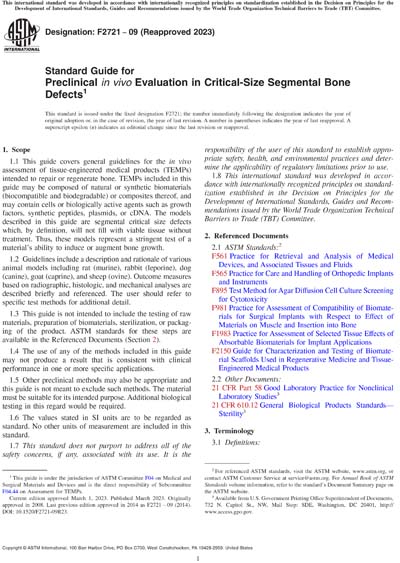Most recent
ASTM F2721-09(2023)
Standard Guide for Preclinical in vivo Evaluation in Critical-Size Segmental Bone Defects
1.1This guide covers general guidelines for the in vivo assessment of tissue-engineered medical products (TEMPs) intended to repair or regenerate bone. TEMPs included in this guide may be composed of natural or synthetic biomaterials (biocompatible and biodegradable) or composites thereof, and may contain cells or biologically active agents such as growth factors, synthetic peptides, plasmids, or cDNA. The models described in this guide are segmental critical size defects which, by definition, will not fill with viable tissue without treatment. Thus, these models represent a stringent test of a material's ability to induce or augment bone growth.
1.2Guidelines include a description and rationale of various animal models including rat (murine), rabbit (leporine), dog (canine), goat (caprine), and sheep (ovine). Outcome measures based on radiographic, histologic, and mechanical analyses are described briefly and referenced. The user should refer to specific test methods for additional detail.
1.3This guide is not intended to include the testing of raw materials, preparation of biomaterials, sterilization, or packaging of the product. ASTM standards for these steps are available in the Referenced Documents (Section 2).
1.4The use of any of the methods included in this guide may not produce a result that is consistent with clinical performance in one or more specific applications.
1.5Other preclinical methods may also be appropriate and this guide is not meant to exclude such methods. The material must be suitable for its intended purpose. Additional biological testing in this regard would be required.
1.6The values stated in SI units are to be regarded as standard. No other units of measurement are included in this standard.
1.7This standard does not purport to address all of the safety concerns, if any, associated with its use. It is the responsibility of the user of this standard to establish appropriate safety, health, and environmental practices and determine the applicability of regulatory limitations prior to use.
1.8This international standard was developed in accordance with internationally recognized principles on standardization established in the Decision on Principles for the Development of International Standards, Guides and Recommendations issued by the World Trade Organization Technical Barriers to Trade (TBT) Committee.
ASTM International [astm]

